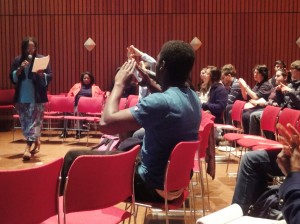Civil Rights Awareness Week, which started on Monday, offered a chance for students to explore potential routes to social justice and examine the history of civil rights here at Grinnell.

The week, sponsored by the Grinnell chapter of the National Association for the Advancement of Colored People (NAACP), began with Monday night’s discussion “Strange Fruit: Are Race and Class Factors in America’s History of Lynching & Capital Punishment?” facilitated by Smounker RLC and chapter advisor Michael A. Hunt and Associate Professor of American Studies and Sociology Kesho Scott.
Monday’s event began with a brief history of race and lynching in America, followed by statistics on race, socioeconomic status and capital punishment and a short summary of the debate over capital punishment in America. Afterwards, students and faculty members discussed their views on capital punishment and the possibility of a connection between that practice and the historical legacy of lynching.
“I was excited to hear the students’ comments and engagement,” Hunt said. “Also, we had staff who showed up who come from other generations too, and so to hear the inter-generational dialogue happening, to me, is what it was all about.”
Though the impetus for Civil Rights Week was student-led, Monday’s discussion topic was Hunt’s idea.
“I did come to them for the ‘Strange Fruit’ conversation, because I knew the work that Kesho [Scott] and I do, and I’m like, ‘Look, this would be a fantastic way to kick off the Civil Rights Awareness Week,’ ” Hunt said. “Because as RLCs we do programming and we’re educators as well, and so we wanted to make sure that they had great programs that included other people from our Grinnell community.”
“That event was very successful,” said NAACP State Representative Maria Maysonet ’14. “A lot of people came out and there was a nice discussion at the end. You got to see people’s different views on capital punishment and how the connection between capital punishment and lynching is there.”
Other events scheduled for Civil Rights Awareness Week were Tuesday’s “Civil Rights: A Pictorial Show,” documenting Grinnell’s civil rights history with archival photos and documents, and Wednesday’s “March for ________” in which students marched from the Black Cultural Center to Bucksbaum Center for the Performing Arts. Student could march for their own specific social justice cause, and students were scheduled to discuss the causes they marched for upon reaching Bucksbaum.
The NAACP also hosted a video screening for Thursday of “Civil Rights Confessionals,” in which Grinnellians reflected on civil rights and the role of NAACP at the College.
“Grinnell students [were] able to see their peers and faculty members talk about Civil Rights Week and why it’s so important on this campus,” Maysonet said.
“Friday, we end with a discussion in JRC 209 from 12 – 1 [p.m.] that’s, well actually, that’s falsely advertised,” said Chapter President Adam Johnston ’13. “It says that Katya’s [Gibel Mevorach, Professor of Anthropology] is supposed to lead it, but when we met with her on Sunday she preferred that we led it. She’s glad to be there, but she’d like to see us lead it and involve a little bit more student interaction.”
In addition to attending the week’s events, NAACP leaders encourage all students to become involved with the organization by attending meetings on Mondays in JRC 209 at 8 p.m.
“We restarted NAACP last year, in doing those meetings, we thought, ‘We need to have a week dedicated to civil rights awareness,’” Johnston said. “Because that’s the emphasis of NAACP, but how does that apply to our generation?”
With Civil Rights Awareness Week and NAACP in general, members hope to spread consciousness and information among students.
“Emphasis on people of color in general, those issues need to be showcased to a broader audience, [as does] the emphasis on doing things on a national level rather than just within like, the Grinnell bubble, which is the one thing that separates us from all the other organizations,” said Johnston.
Though the first Grinnell chapter of the NAACP dates back to the 1950s, the group soon disbanded from the national organization, eventually regrouping as Concerned Black Students. The current NAACP chapter was formed recently, after Hunt contacted students to examine interest in re-forming a Grinnellian chapter.
“It’s very important to have NAACP on this campus,” Maysonet said. “And it’s very important to have this week on this campus, so that people can know what NAACP did for civil rights and the importance of civil rights in the context of Grinnell. Especially at Grinnell, one of our core values is social justice, and so that’s why it’s so important for people to be aware of what happened during the ’60s and how NAACP helped.”


















































